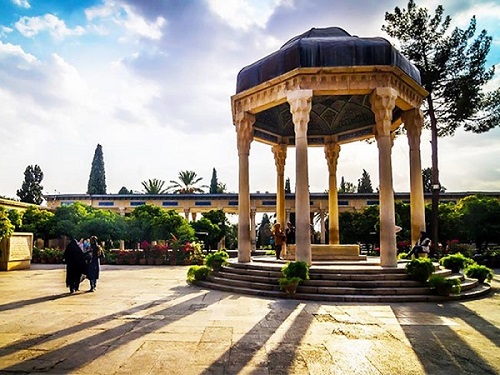Hafez is the most popular of Persian poets. If a book of poetry is to be found in a Persian home, it is likely to be the Divān (collected poems) of Hafez. Many of his lines have become proverbial sayings, and there are few who cannot recite some of his lyrics, partially or totally, by heart.
He was born in 1315 and passed away in 1390 in Shiraz and he never left his city. His full name was “Khajeh Shams-Al din Hafez-e Shirazi” and he was also known as “Lesan-Al gheyb”,“Tarjoman-Al asrar”, “Lesan Al-Orafa” & “Nazem Al-Olia”.
Join visitpars.com and experience this wonderful trip.
His lyrics and poetry have been translated into many European languages and it has brought him a global fame. October 12th is named after him and is being celebrated each year in Iran.

The tomb of Hafez and the surrounding area, formerly known as Takiya-ye Hafez. The Hafeziyeh is located south of the Quran Gate (Darvazeh Quran) on the northern edge of Shiraz, at the beginning of Golestan Street. It is on the site of the famous Golgasht-e Mosalla, the pleasure ground often mentioned in the poems of Hafez, and occupies about 19,000 square meters, incorporating one of Shiraz’s most famous and old cemeteries.
Hafeziyeh is the best sightseeing place when trip to Shiraz.
Most travelers to Shiraz do choose Hafeziyeh as their first sightseeing place due to many reasons. The place is not only the resting place of one of the most prominent poets of Iran who lived eight centuries ago, but also a gathering place for people who come together to enjoy the beautiful garden’s atmosphere and see the gorgeous tilework as well as fine Hafez lyrics which have been carved on the marble stones. The garden itself is filled with sour orange trees and a variety of flowers.
As mentioned above, the place is one of the most touristic places that attracts many visitors and tourists each year. Over the past decades, a number of cultural events have taken place in there such as traditional singer Shajarian concert in 1963 & 1991. Shahram Nazeri has had also a concert in the garden some years ago. The place has been registered as a national heritage in 1975 and new renovations started in 2007 to expand the area adding new green spaces to it as well some more beautiful Iranian architectures.
Hafeziyeh was renovated in 1273 AH by Tahmasb Mirza, the local governor of Fars province. It was again renovated and repaired by Farhad Mirza in 1295 AH, the local governor of Fars province and a wooden monument was built in Hafez’ memory. In 1319 AH, princess Malek Mansour , governor of Fars province ordered a metal monument to be built for tomb of Hafez and an inscription was also built for the place. In 1921, Dabir Azam-e Bahari expanded the sour orange garden around the tomb and made a street right in front of it. He named the street “Kharabat” which is a term that is frequently used in the Hafez poetry. The street later was renamed to “Golestan” which means Rose Garden in Persian language.
In 1925 a modern yet traditional architecture was done to renovate the garden under supervision of great French architect and Iranologist “Andre Godar” during the ministry of Mr. Ali Asghar Hekmat. The construction was finished in 1927 and it is still the same style to this date.
It is believed that the best time of visiting Hafeziyeh is easy spring (April-May) as the weather is so pleasant and moderate in Shiraz and the greenery of its gardens as well as blossomed gardens would made it the most attractive city in Iran. Indeed, May 5th (15th Ordibehesht) is named “Day of Shiraz” in the Persian calendar and is being celebrated each year.